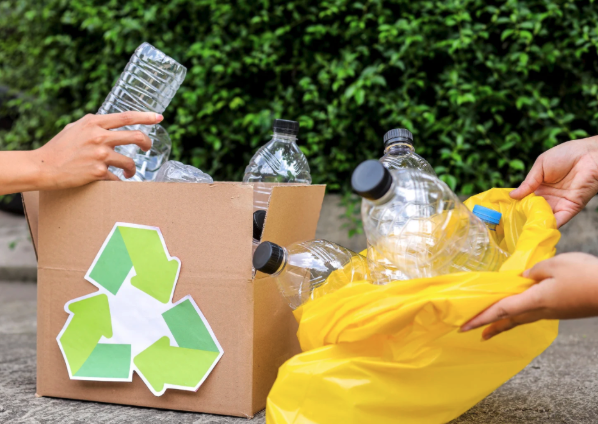Sustainable consumption – how you can make a difference in everyday life

Updated at 2025-11-05
Sustainable consumption and production are central pillars of sustainable development, influencing how resources are used, how goods are made and distributed, and how waste is managed. Every purchase and habit we adopt can help shape more sustainable patterns of living that balance economic growth, social well-being, and environmental protection.
Sustainable consumption is one of the most powerful tools we have in our daily lives – it covers everything from what we eat to how we dress and which things we choose to buy (or not buy). By aligning our actions with the goals of responsible consumption and sustainable management of resources, we contribute to systems that respect both people and planet.
How to consume sustainably – 4 simple principles
The foundation of sustainable consumption is using resources in a way that doesn’t compromise the ability of future generations to meet their needs. It means rethinking consumption and production patterns so that we can substantially reduce waste generation, avoid wasteful consumption, and encourage circular systems that keep materials in use for as long as possible.
Four simple principles for sustainable consumption and production:
- Use what you have – the most sustainable item is the one you already own. Extending product life reduces your material footprint and pressure on the natural environment.
- Choose second-hand, rent, or share when you need something new. This supports a circular economy where resources circulate rather than end up as waste.
- Buy new with care – invest in quality, sustainable materials, and products that can be repaired or recycled. Support companies that adopt sustainable practices and provide transparency in their production and supply chains.
- Plan for the full life cycle – think about how a product can be repaired, resold, or responsibly recycled at the end of its life.
Tip: Want to dive deeper into textiles and material choices? Read our guide to sustainable textile materials.

How to eat sustainably – 4 steps toward a climate-smart diet
Food systems are at the core of sustainable consumption and production. The food we eat contributes significantly to greenhouse gas emissions and global resource use, yet it also offers some of the easiest ways to reduce our impact. Global food waste and food losses along the production and distribution chain are major sustainability challenges. By addressing them, we can monitor sustainable development impacts and promote better economic and environmental aspects of food production.
Four steps toward a more sustainable and responsible diet:
- Eat more plant-based foods – legumes, vegetables, fruits, and whole grains have much lower climate impacts than meat and dairy, reducing both your carbon footprint and material footprint.
- Reduce food waste – plan your shopping, use leftovers creatively, and store food properly to help substantially reduce waste generation and mitigate global food waste.
- Choose seasonal and local produce whenever possible. This supports local economies, reduces transport emissions, and strengthens sustainable management of natural resources.
- Look for certifications like KRAV, EU Organic, or MSC/ASC (for fish), which ensure more responsible consumption and production throughout production and supply chains.

Strategies for sustainable consumption – from individuals to society
To achieve real transformation, we need both individual action and systemic change. Governments, businesses, and consumers must work together to create more sustainable patterns of economic activity that align with the principles of sustainable development and the circular economy.
Strategies on different levels:
- Individual level: Make more conscious purchasing decisions, share resources, and normalize reuse. Support initiatives that substantially reduce waste generation and avoid wasteful consumption.
- Business level: Develop new business models where repair, rental, reuse, and recycling are part of the offering. Companies should engage in sustainability reporting, strengthen scientific and technological capacity, and integrate economic and environmental aspects into their operations.
- Societal level: Support policies that make sustainable choices easier – such as lower VAT on repairs, bans on single-use plastics, or incentives for sustainable management of resources. Public institutions can also help monitor sustainable development impacts and track sustainable development impacts across industries.
- Knowledge and transparency: Labels, product carbon footprints, and education make it easier for consumers to choose responsible consumption options.
- Community and culture: When sustainability becomes part of everyday culture – through clothing swaps, repair cafés, or sharing platforms – it builds collective awareness and supports affected communities in the transition to sustainable consumption and production.

Sustainable consumption and natural resources – why it matters
At its core, sustainable consumption is about how we use the Earth’s natural environment and its resources – land, water, forests, and minerals. Today’s consumption and production patterns put heavy pressure on these limited resources, undermining sustainable development and resilience in affected communities worldwide.
Examples of resource-intensive consumption:
- Textiles require large amounts of water, land, and energy, especially cotton and synthetic fibers.
- Electronics rely on metals and minerals often mined under harsh conditions, creating severe social and environmental impacts.
- Food production drives significant land use and greenhouse gas emissions, particularly from animal-based products.
Ways to use natural resources more sustainably:
- Extend the lifespan of what we already have to reduce the material footprint.
- Choose resource-efficient options – for example, plant-based food, linen, or hemp.
- Support recycling, remanufacturing, and other circular economy practices.
- Protect biodiversity and ensure sustainable management through certifications like FSC or Fairtrade.
Sustainable consumption and chemicals – an often-overlooked perspective
Many everyday products contain chemicals. Some are essential, but others can harm people and ecosystems. Understanding these risks helps promote sustainable management of chemicals and materials.
Challenges include:
- Textiles treated with dyes or water-repellent finishes that release pollutants.
- Plastics with additives that leak microplastics into the environment.
- Electronics containing heavy metals that complicate recycling and disposal.
How to consume more chemical-smart:
- Choose eco-labeled products (GOTS, OEKO-TEX, Nordic Swan, EU Ecolabel) that reflect responsible consumption and sustainable production standards.
- Wash new textiles before use to minimize chemical exposure.
- Avoid unnecessary chemical products at home – opt for natural or fragrance-free alternatives.
- Recycle electronics and hazardous waste properly to protect the natural environment and affected communities near waste sites.
Sustainable consumption and production – two parts of the same whole
UN Sustainable Development Goal 12 focuses on sustainable consumption and production, calling for a shift in both how we consume and how businesses operate. This transformation is key to achieving global sustainable development targets.
What sustainable production means:
- Resource efficiency and renewable energy use
- Non-toxic cycles and cleaner technologies
- Circular design and minimized material footprint
- Transparent and responsible production and supply chains
The link to consumption:
- When consumers demand sustainable alternatives, they drive economic growth toward more sustainable patterns.
- When we reduce overconsumption, we ease the strain on ecosystems and affected communities.
- When companies adopt sustainable practices and share their sustainability reporting, we can monitor sustainable development impacts and encourage accountability across industries.
Sustainable consumption in a global perspective
Our consumption choices in Sweden and other high-income regions have impacts far beyond our borders. Clothes, electronics, food, and furniture are often produced in countries where natural resources are extracted cheaply and labor conditions are poor. Global trade connects production and supply chains across continents – but it also spreads the economic and environmental aspects of consumption.
Key aspects:
- Working conditions: Many workers in global production and supply chains face low wages and weak labor protections. Choosing transparent companies helps improve these conditions and supports sustainable management.
- Environmental impact: Production in many regions relies on fossil fuels and generates high greenhouse gas emissions.
- Water and land use: Cotton farming in arid regions, soybean cultivation in South America, and palm oil plantations in Southeast Asia all put pressure on local ecosystems and affected communities.
- Transport: Imported goods create emissions from shipping and aviation, although production itself often has a much larger footprint.
How we can make a difference:
- Choose certified products like Fairtrade, Rainforest Alliance, or FSC, which integrate economic and environmental aspects and protect affected communities.
- Demand transparency – ask companies where and how their products are made.
- Support businesses that adopt sustainable practices, report their sustainability performance, and work toward a circular economy.
- Reduce overconsumption – fewer purchases mean less waste, lower emissions, and healthier consumption and production patterns.
Thinking globally about our consumption means recognizing that sustainability isn’t only about the environment – it’s also about social equity, sustainable development, and the fair distribution of resources.
Small steps, big impact
It’s easy to feel overwhelmed by the climate challenge. But every time you repair instead of replace, or choose a plant-based meal instead of meat, you’re part of the shift toward sustainable consumption and production. The more people make these choices, the stronger the momentum for systemic change – from individual behavior to corporate sustainability reporting and national policies that monitor sustainable development impacts.
By rethinking our habits, supporting fair and transparent production and supply chains, and building scientific and technological capacity for innovation, we can create a world where economic growth goes hand in hand with protecting the natural environment and empowering affected communities.
Curious about how your company can take responsibility for its consumption and take sustainability work to the next level?
GoClimate automatically calculates your company’s carbon footprint and provides data on social sustainability and governance (ESG) based on invoices and receipts – making it easier to track economic and environmental aspects and monitor sustainable development impacts. Get started today!